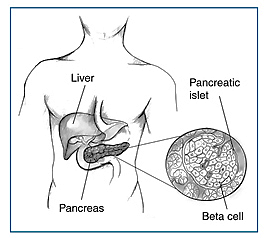Type 1 Diabetes, also known as diabetes mellitus type 1, is a condition characterized by the impaired ability of one’s pancreas to produce insulin. In an individual with type 1 diabetes, the immune system malfunctions and attacks the beta cells of the pancreas, which are responsible for producing insulin. This classifies type 1 diabetes as an autoimmune disease, which is where the immune system attacks the body, thus it is currently incurable. The current treatment for this condition involves daily injections of insulin to allow the individual to regulate their blood sugar levels. Unfortunately, insulin therapy has side effects, such as hypoglycemia (low blood glucose levels) or hyperglycemia (high blood glucose levels) from incorrect dosages, and some individuals may be allergic to the preservatives added to insulin medication. Furthermore, insulin therapy involves precise control of blood sugar levels, and this is very difficult to achieve, often causing patients to face long-term medical problems as a result.
So what is this new potential cure? It began in 2014, when a team of Harvard University researchers used human stem cells, unspecialized cells that can become cells with a specific function, to create new beta cells in large quantities, as published in Cell. This new technique of creating insulin producing cells from human embryonic stem cells was a big step in diabetes research. In further experiments, these beta cells were transplanted into diabetic mice, as an attempt to replace the destroyed beta cells. Unfortunately, the immune system in the mice destroyed these new beta cells as well.
A team of researchers from MIT and several other institutions have devised an “invisibility cloak” for the beta cells, so they can hide from the faulty immune system. The cloak is composed of modified alginate, which is a material isolated from brown algae. After testing 800 various derivatives of this alginate capsule, they chose the best capsule from the tests, known as triazole-thiomorpholine dioxide (TMTD). This research was shown in a recently posted article in the Nature Biotechnology journal.
The results were incredible! As a study in Nature Medicine showed, the injected mice were able to produce insulin until the implants were removed 174 days later. This has massive implications for diabetes therapy, as not being dependent on insulin injections is the end goal. If these implants were able to function in humans, then the diabetic individuals would not require insulin injections anymore. The next step of research is to move from trials on mice to trials on primates. If the tests on primates show positive results, the step after would be human trials. Researchers are making large strides towards a cure for type 1 diabetes.
– Kush Khanna



